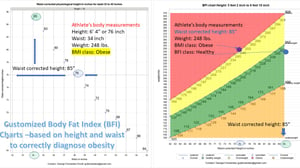Nevada statistician discovers improved way to classify obesity: Move away BMI! Welcome BFI.
December 1, 2020
 Body Mass Index, or BMI, is a universal index to classify obesity. One of BMI’s limitations is that it can’t differentiate between muscle and fat, so even Olympic athletes can be classified as obese. On the other end, people with high levels of visceral fat who are at significant health risk can pass entirely under the BMI radar.
Body Mass Index, or BMI, is a universal index to classify obesity. One of BMI’s limitations is that it can’t differentiate between muscle and fat, so even Olympic athletes can be classified as obese. On the other end, people with high levels of visceral fat who are at significant health risk can pass entirely under the BMI radar.
Waist circumference provides a unique indicator of body fat distribution, which can identify patients who are at risk for obesity-related diseases more effectively than the current BMI based classification. To correct the limitations of BMI, George Fernandez, a senior analytical consultant at SAS Institute and a retired professor of applied statistics at the University of Nevada, Reno, is proposing a new Body Fat Index (BFI) which incorporates waist circumference, in addition to body weight and height measurements in BFI computation.
“Using SAS software, I discovered a much-improved way of classifying obesity-overweight, which closely corresponds to BMI charts,” said Fernandez. “For example, BMI wrongly classify an athlete’s body measurements (weight: 242 lbs., height: 75 inches and waist: 32 inches) as obese (BMI of 30.24). In contrast, the BFI calculation correctly classifies this athlete’s body measurements as a healthy weight, with an equivalent BMI of 22.02. Using another example, BFI classifies the following body measurements of 160 lbs. weight, 68 inches height and 38 inches waist as obese (a BMI equivalent of 24.32); however, the BMI chart for these same measurements wrongly suggests a healthy weight.”
To calculate BFI in metric and imperial units, the height is corrected by waist measurement, then this corrected physiological height is substituted in place of the actual height; therefore, a similar formula to that of BMI can be used. Additionally, BFI uses the same obesity classification as the Body Mass Index. For more information on BFI computation and to download user-friendly customized height specific BFI charts, please follow this link.
Using SAS Survey procedures and data from the National Health and Nutrition Examination Surveys revealed that BFI based obesity-overweight classification accurately estimate national overweight and obesity percentages. Furthermore, BFI based obesity-overweight classification is a better predictor than BMI in predicting type 2 diabetes after controlling for age, gender and race – ethnicity. Fernandez will be presenting his findings at the SAS Ask the Expert Webinar at 1:00 p.m. ET, December 15th 2020.
“My studies and efforts in this area haves culminated to this simple-to-use BFI formula and user-friendly charts, which will be useful in medically underserved areas of the world especially during this Covid-19 pandemic, and for individuals without access to advanced statistical software,” added Fernandez.. “Anyone, anywhere, can calculate their BFI if they know their weight, height and waist measurements using this simple formula or from the downloadable user-friendly charts.”
About George Fernandez
George Fernandez, retired Professor of Applied Statistics and Director for the University of Nevada -Reno's Center for the Research Design Analysis, currently serves as a Senior Analytical consultant at SAS. With more than 30 years of experience in teaching advanced analytical courses, he provides training in predictive modeling, forecasting, text analytics, model management and survey analysis.
www.max-weight-limit.com





